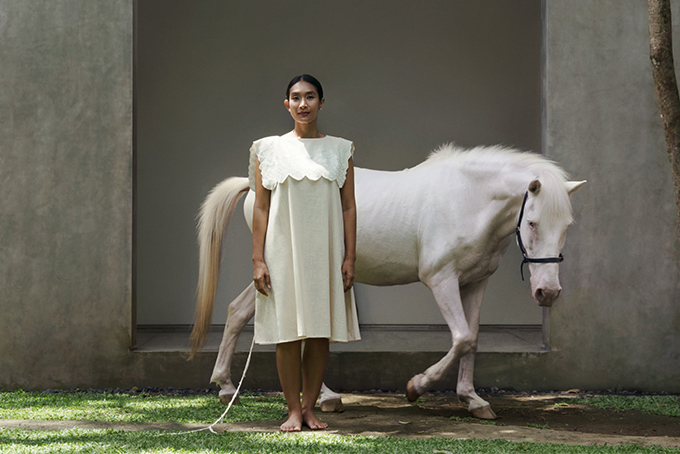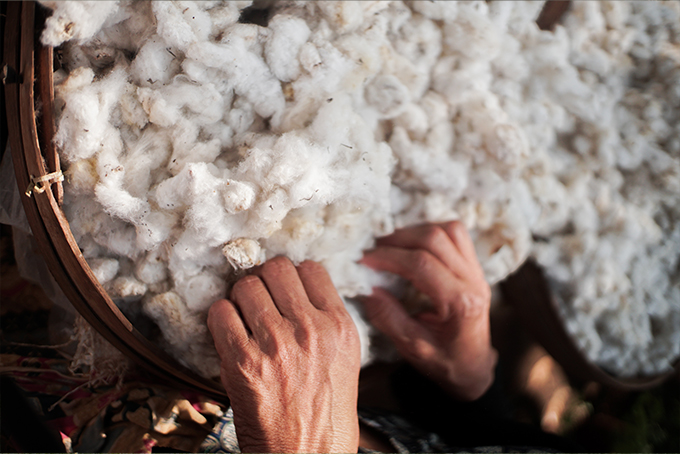SukkhaCitta—which means happiness in Sanskrit—was founded on heartbreak. The story begins with the sorrowful homecoming of Denica Riadini-Flesch, who returned to Indonesia after training as a development economist in Rotterdam to scenes of abject and endemic poverty. Disillusioned with the false promises of development aid, she launched SukkhaCitta in 2016 as a rebuke to the reigning system of exploitation, one which spares neither people nor the planet. Their ethos is expansive, resting on three tenets: providing a living wage to all artisans, preserving heritage and saving the earth.
“We are responsible,” says Anastasia A. Setiobudi, creative director of SukkhaCitta, “not just sustainable.” Their garments are made entirely by hand; grown, woven, sewn, dyed and decorated using indigenous techniques by the unseen artisans of Indonesia, the village ibus-ibus. Profits fund the Rumah SukkhaCitta, a vocational school for ibus with a mixed curriculum of craft and business skills so that enterprising graduates may go their own way. To date, they have transformed the lives of 1,500 artisans in seven villages. It’s a model that has earned them countless plaudits, from the Cartier Women’s Initiative Award to the DBS Bank Social Enterprise Award. They are also the first Indonesian fashion brand to be B-Corp certified, a distinction reserved for brands who meet the highest social and environmental standards.


But their clothes are more than an afterthought. Often, the trouble with consciously made clothes is a certain frumpishness in design, the unhappy consequence of style turned marginal to the mission. Not so for SukkhaCitta. Their extraordinary garments are designed by a team led by Setiobudi, who trained in London and Bali before decamping to the villages in search of meaningful work. Consider the latest KAPAS collection, a modern take on the kebaya. Among the standout pieces, there is the hand-stitched pearl top: a sleeveless blouse with a panel of fine pleats running down the middle, bisected by a gossamer line of dainty pearls.
See also the Nona dress, Setiobudi’s favourite, a delightful shift with a large bib collar, embroidered with subtle motifs of the flora found on their cotton farms. For men, there is the spiffy Nerd shirt, a patchwork short sleeved button-down quilted together from fabric off-cuts. The clothes are the raw ivory of unbleached cotton and each piece catches the light differently. Grinning, Setiobudi declares “no two pieces are the same.” Setiobudi calls the collection “nostalgic.” “I wanted to evoke the feeling of childhood,” she says. The Nona dress was inspired by a pattern she used to wear as girl and the riffs on the kebaya have their origin in the one her grandmother wore daily. These are clothes that are easy to admire.


Yet, the product never obscures its provenance. Setiobudi takes pains to point out that each piece bears the mark of its makers—both the ibus and the earth. “One garment takes 12 ibus to make,” she reveals. With alacrity, she details the production process. The collection was made entirely from heirloom Indonesian cotton, grown in the traditional way. “We use an ancient technique known as Tumpang Sari,” she says, “Cotton is planted with other crops to heal the damaged soil.” It may be ancestral wisdom but science has a name for its salubrious effects–regeneration. Ever ambitious, the brand has pledged to use 100% regenerative cotton by 2025, on top of regenerating 1,000 hectares of land. It will be an arduous process. “It took four years to grow enough cotton for the collection,” admits Setiobudi, “but this is what we are all about.”
It is a difference immediately felt, for the material is distinct to the touch. The shorter fibre of the indigenous cotton makes for a thicker fabric, heavier than the typical Indian cotton but just as breathable due to expert hand-weaving. To wear it is to feel a comforting weight. Like all woven material, its texture is variegated, surprising; a landscape of sensations, it is bumpy in places where a cotton seed has caught, rough in parts, smooth in others. Everywhere, there is evidence of the hand. It can be visceral. “Customers tell me they feel connected to the ibus when they wear our clothes,” she says.

Those enticed can celebrate; the brand has alighted in Singapore for a brief sojourn. From now till 14 May, a curated selection of SukkhaCitta’s star products can be shopped at the ZERRIN pop-up store at Anchorpoint Shopping Centre.
ZERRIN at Anchorpoint Shopping Centre, Level 1 is open daily from 10 a.m. to 7 p.m.





